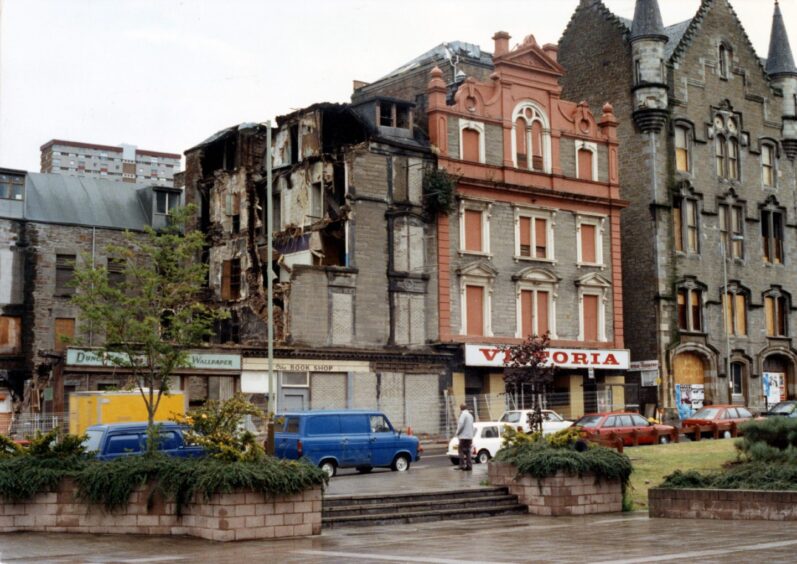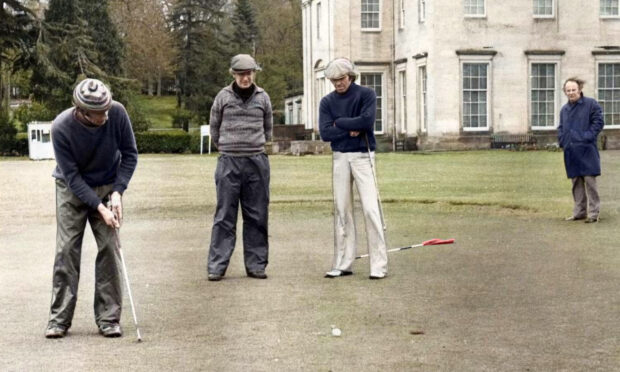
The final credits rolled on the Victoria Cinema in Dundee in August 1990 when the beloved old building was torn down.
The Vic on Victoria Road was popular with generations of theatre then cinema-goers.
The fate of the historic landmark was sealed after structural faults were discovered.
The building began life as the Royal Victoria Theatre which opened in 1842.
Plays continued to be staged at the Vic until 1903.
Alterations were made and the building was converted into a music hall to meet popular demand and opened under the name of the Gaiety Theatre.
The Gaiety had a luxurious entrance.
From it a cascade of light spilled across Victoria Road and spread its magic from the Wellgate Steps to Cotton Road.
A play to chill the marrow of your bones
The Gaiety brought the glamour of the flesh-and-blood theatre to Dundee.
The audiences were raucous and rowdy and the atmosphere filled with the odour of stale beer, black tobacco, jute mill stoor and fish and chips.
Plays included The Face at the Window, The Dumb Man of Manchester, The Murder in the Red Barn, Man to Man and The Ticket-of-Leave Man.
The audience cheered the hero’s defiant speeches and booed the villain’s threats.
Some of the biggest stars of the day trod the boards at the Gaiety.
Marie Lloyd was a huge draw in February 1908 and known for innuendo-laden songs such as Oh You Wink the Other Eye and A Little of What You Fancy.
Sir George Robey was known as the Prime Minister of Mirth and performed in February 1909 where his appearance was hailed with deafening cheers.
Walford Bodie brought his high-voltage brand of magic to the Gaiety in June 1913.
Bodie thrilled crowds and his jaw-dropping act included his cage of death and an electric chair which seemingly passed 30,000 volts through his body.
Music hall gave way to cinema and brought about another change.
Becoming the Victoria Palace Theatre
The Gaiety was put up for sale in July 1915.
The building was bought by theatre impresario Robert Colburn Buchanan for £1,600.
The interior was entirely remodelled including new seating throughout.
The colour scheme was “rich tones of ivory and old gold”.
A new entrance vestibule was formed, with an entrance waiting hall, richly panelled in polished mahogany, with swing doors and polished terrazzo flooring.
The name changed to the Victoria Palace Theatre and it became a cinema during the silent era of Charlie Chaplin, Greta Garbo and Buster Keaton.
The transformation cost several thousands and was carried out in five weeks.
The first film shown was The Avenging Conscience and the cinema began to gain a high reputation for the “splendid fare it was providing week after week”.
It changed hands again a few times.
Robert Saunders bought the Vic which went back to live theatre use in November 1922.
Harry Hay’s Find the Lady was the opening attraction.
Live stage entertainment including variety shows were prosperous but then faced increased competition from talking pictures in the 1930s.
If you can’t beat them, join them
Mr Saunders was granted a cinema licence by Dundee magistrates in 1934.
The ink was barely dry before the Vic was sold to John Bannerman Milne who had the largest cinema chain under private ownership in Scotland.
He decided to carry on as a theatre.
The building was completely renovated to make it “brighter and more comfortable” including 500 feet of neon lighting in red and blue at the entrance.
For 12 months he provided variety entertainment at the Vic.
This was followed by six months of dramatic plays.
Then came the conversion to films.
The Vic became one of the most modern cinemas in Scotland.
The cinema was completely gutted by a disastrous fire in January 1940 when a cigarette end was dropped in the balcony.
Following extensive refurbishment the Vic reopened with a showing of Each Dawn I Die featuring James Cagney and George Raft.
The Vic had two balconies with the top one being known as “the gods”.
It proved to be a popular cinema for decades.
Cinemas began closing at an unprecedented rate in the 1960s due to the rise of television but the Vic managed to survive in a declining market.
Crocodile Dundee broke records in 1987
The Vic screened the biggest movies of the 1970s like Live and Let Die, The Towering Inferno, Jaws, King Kong, Star Wars and Superman.
The blockbusters were often shown a few months after release.
The 1980s was an amazing decade for movies.
Raiders of the Lost Ark, Octopussy, Beverly Hills Cop and Top Gun were among them.
Some movies were more popular than others.
Rocky 4 with Sylvester Stallone was an instant hit in 1986.
It was released at the Vic on January 24 and was still running to full houses in March.
Crocodile Dundee in 1987 brought a 14-week record run.
And record box office receipts.
The Vic was a constant but things were changing in Victoria Road.
Beginning of the end for famous building
Buildings were being demolished to make way for Dundee’s £14m inner ring road.
The release of Honey, I Shrunk the Kids in February 1990 sparked unprecedented scenes with hundreds of people being turned away from screenings.
More than 1,000 people queued up for the 350 seats.
Every night was sold out.
There was a bigger headache to come.
Health officials closed down the Vic in May 1990.
A number of structural faults were discovered in the building.
A closure notice was served on the management.
Plaster work was defective.
Emergency and normal lighting was not working properly.
A tie bar holding the roof above the seating of the upper balcony had been removed.
There was also a fire risk from material underneath the stage.
Cinema-goers who turned up to watch Pretty Woman found the doors locked.
The structural problems were too costly to repair.
It was a sad end for one of the city’s remaining cinemas.
Fleas were left homeless when end came for Victoria cinema
The projection equipment was removed and much of the roof was brought down.
The building was completely levelled in August 1990.
Pamela Mulgrew, author of Let’s Go to the Pictures: Memories of Cinema in Dundee, said the Vic suffered from years of neglect before the end came.
“The Vic was one of the cinemas in Scotland that was opened the longest,” she said.
“That said, by the 1960s and 1970s it really was beginning to be a bit of a mess due to chronic lack of investment.
“The balconies, one by one, were closed for safety reasons.
“By the time it closed in 1990, it really was very unsafe and filthy.
“I had a rat run over my foot at one film I went to see and I believe other patrons also came home from the cinema carrying a few unwanted guests – fleas!”




















Conversation